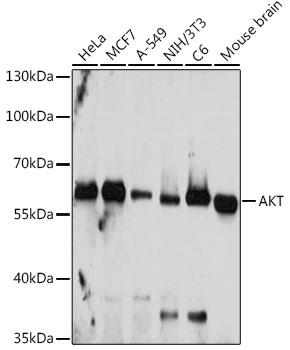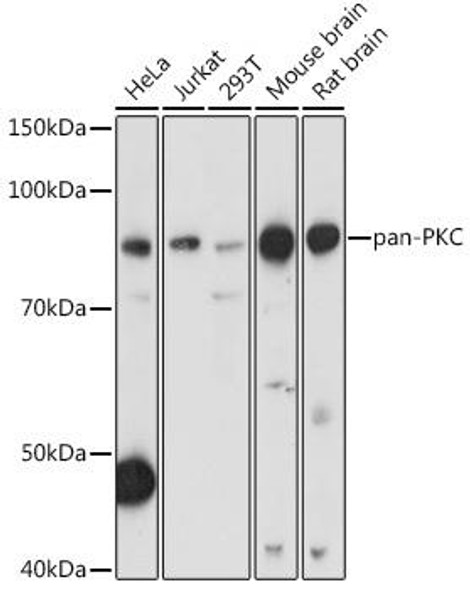Cell Biology Antibodies 15
Anti-Pan-AKT Antibody (CAB18120)
- SKU:
- CAB18120
- Product Type:
- Antibody
- Reactivity:
- Human
- Reactivity:
- Mouse
- Reactivity:
- Rat
- Host Species:
- Rabbit
- Isotype:
- IgG
- Research Area:
- Cell Biology
Description
| Antibody Name: | Anti-Pan-AKT Antibody |
| Antibody SKU: | CAB18120 |
| Antibody Size: | 20uL, 50uL, 100uL |
| Application: | WB IHC IF IP |
| Reactivity: | Human, Mouse, Rat |
| Host Species: | Rabbit |
| Immunogen: | A synthetic peptide of human AKT1/AKT2/AKT3 |
| Application: | WB IHC IF IP |
| Recommended Dilution: | WB 1:500 - 1:1000 IHC 1:50 - 1:100 IF 1:50 - 1:100 IP 1:50 - 1:100 |
| Reactivity: | Human, Mouse, Rat |
| Positive Samples: | HeLa, MCF7, A-549, NIH/3T3, C6, Mouse brain, Rat brain |
| Immunogen: | A synthetic peptide of human AKT1/AKT2/AKT3 |
| Purification Method: | Affinity purification |
| Storage Buffer: | Store at -20°C. Avoid freeze / thaw cycles. Buffer: PBS with 0.02% sodium azide, 50% glycerol, pH7.3. |
| Isotype: | IgG |
| Sequence: | Email for sequence |
| Gene ID: | 207/208/10000 |
| Uniprot: | P31749/P31751/Q9Y243 |
| Cellular Location: | |
| Calculated MW: | 48kDa/55kDa/51kDa/54kDa |
| Observed MW: | 60kDa |
| Synonyms: | AKT1/AKT2/AKT3 |
| Background: | Human AKT serine-threonine protein kinase family includes three members AKT1, AKT2, AKT3, which are also often referred to as protein kinase B alpha, beta, and gamma. These highly similar AKT proteins all have an N-terminal pleckstrin homology domain, a serine/threonine-specific kinase domain and a C-terminal regulatory domain. These proteins are phosphorylated by phosphoinositide 3-kinase (PI3K). AKT/PI3K forms a key component of many signalling pathways that involve the binding of membrane-bound ligands such as receptor tyrosine kinases, G-protein coupled receptors, and integrin-linked kinase. These AKT proteins therefore regulate a wide variety of cellular functions including cell proliferation, survival, metabolism, and angiogenesis in both normal and malignant cells. AKT proteins are recruited to the cell membrane by phosphatidylinositol 3, 4, 5-trisphosphate (PIP3) after phosphorylation of phosphatidylinositol 4, 5-bisphosphate (PIP2) by PI3K. Subsequent phosphorylation of both threonine residue 308 and serine residue 473 is required for full activation of the AKT1 protein encoded by this gene. |







